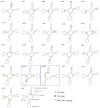The Characterization of the Mitochondrial Genome of Fulgoraria rupestris and Phylogenetic Considerations within the Neogastropoda
- PMID: 39202435
- PMCID: PMC11353978
- DOI: 10.3390/genes15081076
The Characterization of the Mitochondrial Genome of Fulgoraria rupestris and Phylogenetic Considerations within the Neogastropoda
Abstract
Fulgoraria rupestris is a predatory marine gastropod belonging to Neogastropoda and possessing considerable taxonomic significance. However, research on this species remains limited. We acquired the complete mitochondrial genome of F. rupestris through second-generation sequencing and conducted an analysis of its genome structural features. The mitochondrial genome of F. rupestris spans a total length of 16,223 bp and encompasses 37 genes (13 protein-coding genes (PCGs), 22 transfer RNAs, and 2 ribosomal RNAs). Notably, most tRNAs exhibit the typical cloverleaf structure, but there is an absence of the Dihydrouridine (DHU) arm in the trnS1 and trnS2 genes. The A + T content is 68.67%, indicating a pronounced AT bias. Additionally, we conducted a selection pressure analysis on the mitochondrial genomes of four species within Volutidae, revealing that all PCGs are subjected to purifying selection. In comparison to other species within Neogastropoda, F. rupestris shares an identical gene arrangement. Additionally, based on mitochondrial genome sequences of the 13 PCGs from 50 species within Neogastropoda, we constructed a phylogenetic tree. The phylogenetic tree indicates F. rupestris forms a clade with species within the family Volutidae (Cymbium olla, Neptuneopsis gilchristi, and Melo melo). This study serves as a valuable reference for future research on F. rupestris, offering insights for the upcoming phylogenetic and taxonomic classification within Neogastropoda. Furthermore, the findings provide valuable information for the development of genetic resources in this context.
Keywords: Fulgoraria rupestris; Neogastropoda; mitochondrial genome; phylogenetic analysis.
Conflict of interest statement
The authors declare no conflict of interest.
Figures







Similar articles
-
Neogastropod phylogenetic relationships based on entire mitochondrial genomes.BMC Evol Biol. 2009 Aug 23;9:210. doi: 10.1186/1471-2148-9-210. BMC Evol Biol. 2009. PMID: 19698157 Free PMC article.
-
The complete mitochondrial genome of marine gastropod Melo melo (neogastropoda: volutoidea).Mitochondrial DNA B Resour. 2019 Nov 20;4(2):4161-4162. doi: 10.1080/23802359.2019.1693293. Mitochondrial DNA B Resour. 2019. PMID: 33366363 Free PMC article.
-
The complete mitochondrial genome of Gyrodactylus pseudorasborae (Platyhelminthes: Monogenea) with a phylogeny of Gyrodactylidae parasites.BMC Genomics. 2025 Jan 14;26(1):34. doi: 10.1186/s12864-025-11225-5. BMC Genomics. 2025. PMID: 39810079 Free PMC article.
-
The complete mitochondrial genome of Babylonia borneensis (Gastropoda: Neogastropoda: Buccinidae).Mitochondrial DNA A DNA Mapp Seq Anal. 2016 Sep;27(5):3534-5. doi: 10.3109/19401736.2015.1074205. Epub 2016 Mar 17. Mitochondrial DNA A DNA Mapp Seq Anal. 2016. PMID: 27158871
-
Sequence comparison of the mitochondrial genomes of Plesionika species (Caridea: Pandalidae), gene rearrangement and phylogenetic relationships of Caridea.PeerJ. 2024 May 22;12:e17314. doi: 10.7717/peerj.17314. eCollection 2024. PeerJ. 2024. PMID: 38799064 Free PMC article.
References
-
- Ponder W.F., Colgan D.J., Healy J., Nützel A., Simone L.R., Strong E.E. Molluscan Phylogeny. University of California Press; Berkeley, CA, USA: 2008. Caenogastropod phylogeny.
-
- Bernard F. Recherches sur les Organes Palléaux des Gastéropodes Prosobranches. G. Masson; Paris, France: 1890.
-
- Bouchet P., Lozouet P., Maestrati P., Heros V. Assessing the magnitude of species richness in tropical marine environments: Exceptionally high numbers of molluscs at a New Caledonia site. Biol. J. Linn. Soc. 2002;75:421–436. doi: 10.1046/j.1095-8312.2002.00052.x. - DOI
-
- Ponder W.F. Mollusca: The Southern Synthesis. CSIRO Publishing; Melbourne, Australia: 1998. Brief introductions to higher groups of gastropods: Infraorder Neogastropoda; pp. 808–854.
-
- Ponder W., Lindberg D.R. Phylogeny and Evolution of the Mollusca. University of California Press; Berkeley, CA, USA: 2008.
MeSH terms
Substances
Grants and funding
LinkOut - more resources
Full Text Sources

